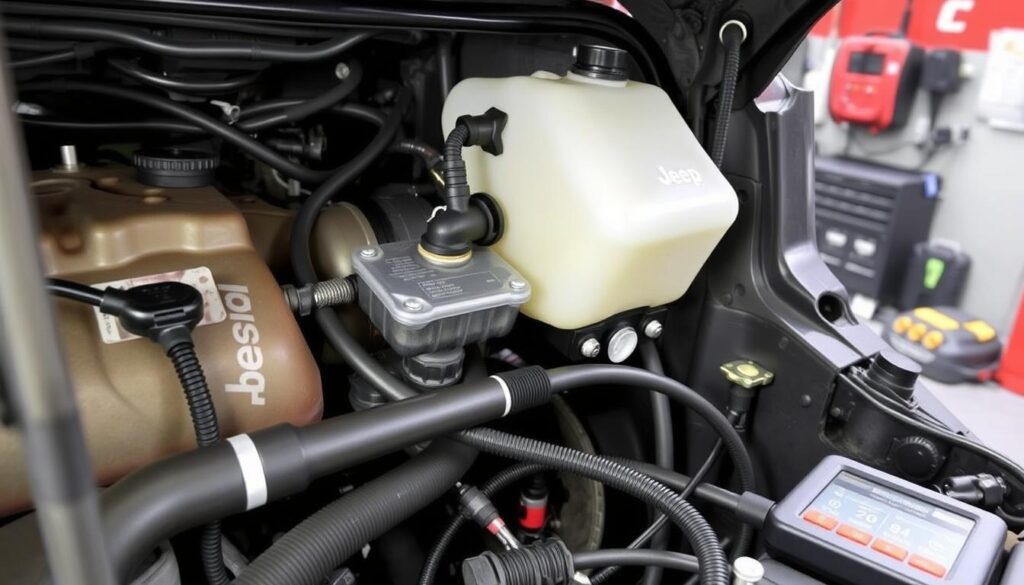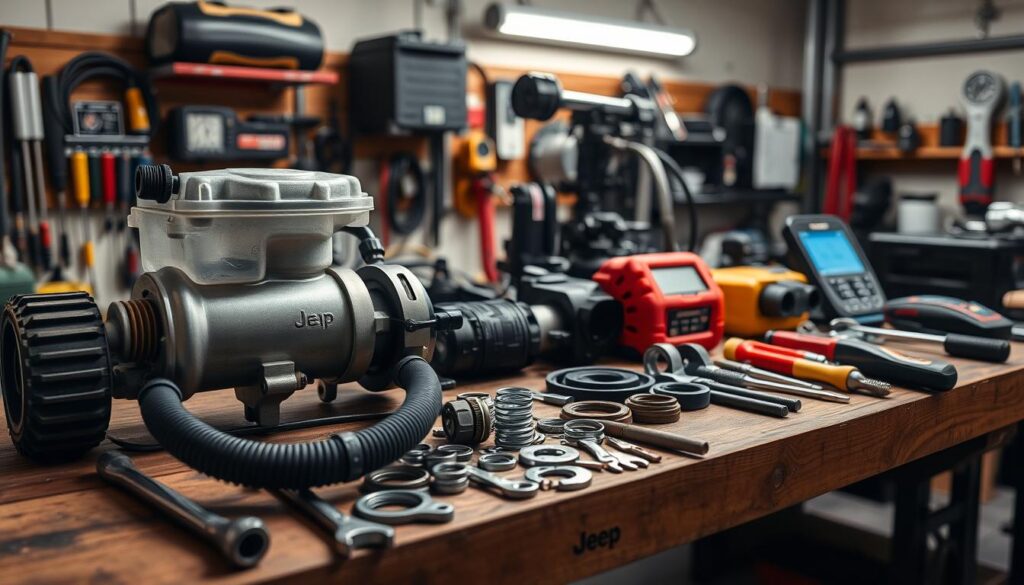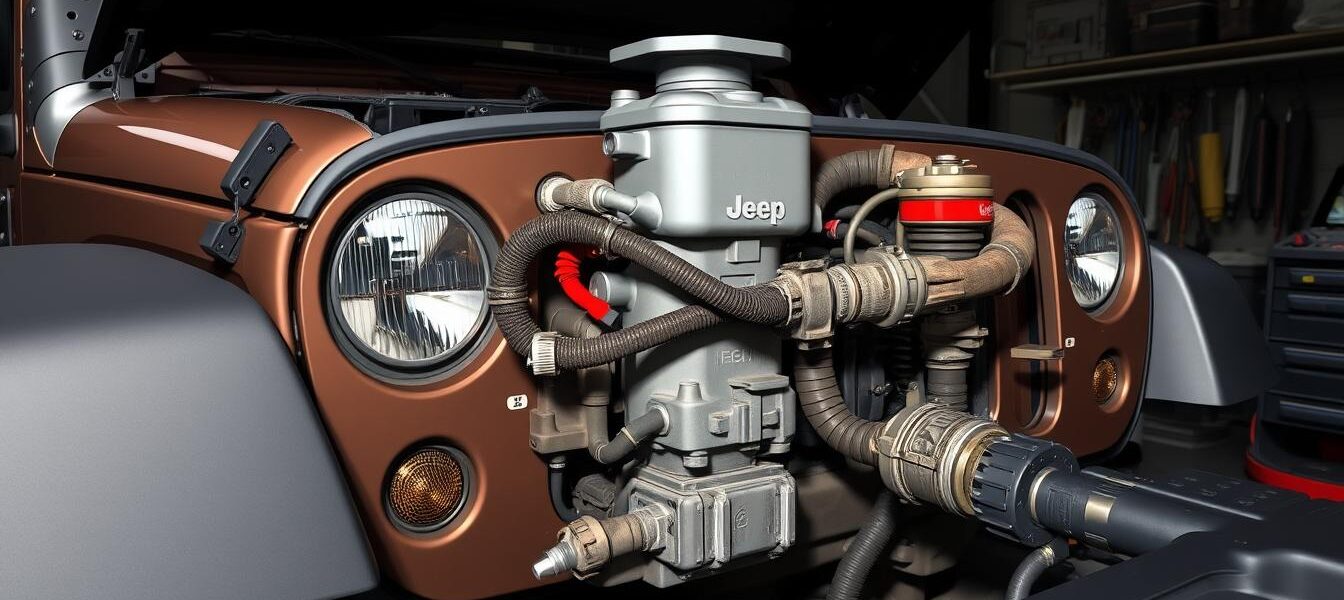Fix P0456 Jeep Code: EVAP System Leak Guide
The P0456 code in Jeeps signals a tiny leak in the EVAP system. This system stops gas fumes from polluting the air. The leak is super small, about 2 microns, making it hard to find.
Fixing this issue is key for your Jeep’s health. It helps maintain fuel efficiency and ensures you pass emissions tests. It also keeps your Jeep running at its best.
Key Takeaways
- The P0456 code indicates a very small leak in the Jeep’s EVAP system, often less than 0.020 inches in diameter.
- Common causes include a loose or damaged gas cap, faulty EVAP hoses, or malfunctioning EVAP system components.
- Addressing the P0456 code is crucial for maintaining fuel efficiency, passing emissions tests, and ensuring optimal vehicle performance.
- Utilizing an OBD-II scanner and performing visual inspections and smoke tests can help diagnose the root cause of the P0456 code.
- Replacing the gas cap, inspecting and replacing EVAP hoses, and repairing or replacing the charcoal canister are common solutions for fixing the P0456 code.
Understanding the P0456 Code in Jeep Vehicles
The P0456 trouble code in Jeeps relates to the Evaporative Emission Control (EVAP) system. It can be tricky to diagnose and fix. Let’s explore what this code means and how it affects your Jeep.
What Does the P0456 Code Mean?
P0456 signals a tiny leak in the EVAP system, usually smaller than 0.020 inches. Drivers often miss this, but the Powertrain Control Module (PCM) can detect it. The PCM is designed to find even the smallest issues.
Common Symptoms of the P0456 Code
- Illuminated Check Engine Light (CEL)
- Decreased fuel efficiency
- Increased emissions
- Potential disabling of the remote start feature
How It Affects Vehicle Performance
The P0456 code can significantly impact your Jeep’s performance and emissions. Fuel vapors may escape through the small leak, reducing efficiency. This can lead to higher emissions and lower fuel economy.
The PCM might disable the remote start feature as a safety measure. This helps prevent further issues from developing. It’s crucial to address the problem quickly for optimal powertrain function.
“The EVAP system test typically occurs when the engine is cold-soaked overnight, at specific temperatures, and with fuel levels within a certain range.”
Understanding the P0456 code helps you maintain your Jeep’s EVAP system. This ensures efficient operation and helps pass emissions tests. Next, we’ll explore the EVAP system and common causes of the P0456 code.
The EVAP System: How It Works
The Evaporative Emission Control (EVAP) system manages fuel vapors in jeep grand cherokee problems and jeep wrangler fault codes vehicles. It captures and stores fuel vapors to reduce emissions. This system prevents air pollution by containing vapors that would otherwise escape.
Components of the EVAP System
The EVAP system has several key parts. These include the gas cap, fuel tank, fuel lines, purge valve, and charcoal canister. Together, they contain fuel vapors and direct them back to the engine for burning.
The Role of the Charcoal Canister
The charcoal canister is the EVAP system’s core. It’s filled with activated charcoal that adsorbs and stores fuel vapors. When the engine runs, the purge valve opens. This allows the engine to draw in stored vapors for combustion.
Importance of Evaporative Emission Control
The EVAP system’s integrity is vital for meeting environmental standards. It helps reduce air pollution and improve fuel economy. A well-functioning EVAP system can extend the life of emissions-related components.
This leads to better vehicle performance overall. It also helps reduce maintenance costs in the long run.
“The EVAP system is a critical component in modern vehicles, ensuring that harmful fuel vapors are captured and recycled back into the engine, rather than being released into the atmosphere.”
| OBD-II Code | Description |
|---|---|
| P0454 | Evaporative Emission Control System Pressure Sensor Circuit Intermittent/Erratic |
| P0456 | Evaporative Emissions System Small Leak Detected |
| P0440 | Evaporative Emission Control System Malfunction |
| P0455 | Evaporative Emission Control System Leak Detected (gross leak) |
| P0442 | Evaporative Emission Control System Leak Detected (small leak) |
Common Causes of the P0456 Code
A P0456 code on your Jeep’s check engine light needs quick attention. It shows a tiny leak in the EVAP system. Common causes include gas cap issues, EVAP hose leaks, and faulty charcoal canisters.
Loose or Damaged Gas Cap
A loose or damaged gas cap often triggers the P0456 code. Even a slightly loose cap can cause a small EVAP leak. Check your gas cap for proper sealing.
Replace it if needed to fix the issue. This simple step can often solve the problem.
Leaks in the EVAP Hoses
EVAP hose leaks are another frequent cause of the P0456 code. Inspect these hoses for cracks, holes, or loose connections. Replace any damaged hoses to resolve the issue.
Faulty Charcoal Canister
The charcoal canister captures and stores fuel vapors in the EVAP system. A faulty canister can trigger the P0456 code. Check for damage or fuel contamination in the canister.
Some Jeep models have known EVAP system issues. Check jeep mechanics forums and chrysler technical service bulletins for model-specific insights.
Understanding these common causes helps you diagnose and fix P0456 issues. This ensures your Jeep’s EVAP system works correctly. Proper maintenance keeps your vehicle running smoothly.
Diagnosing the P0456 Code
Finding the source of a P0456 code in your jeep can be challenging. This error indicates a tiny leak in the Evaporative Emission Control (EVAP) system. With the right tools and methods, you can solve the issue.
Restoring your jeep’s emissions system to full health is possible. By following a systematic approach, you’ll be able to identify and fix the problem.
Using an OBD-II Scanner
Start by connecting an OBD-II scanner to your jeep’s diagnostic port. This tool retrieves additional trouble codes and provides real-time data about the system.
The scanner helps identify valuable clues about the leak’s source. It’s an essential first step in diagnosing the P0456 code.
Visual Inspections for Leaks
After getting OBD-II data, inspect your jeep’s EVAP system closely. Check all hoses, connections, and components for signs of wear or damage.
Look for loose fittings that could cause leaks. Even a tiny crack can trigger the P0456 code.
Smoke Testing for EVAP System Leaks
If visual inspection fails, try smoke testing. This method injects special smoke into the EVAP system.
A smoke detector then pinpoints exact leak locations. It’s great for finding small leaks that are hard to spot.
| Diagnostic Tool | Purpose | Typical Cost |
|---|---|---|
| OBD-II Scanner | Retrieve trouble codes and access real-time data | $20 – $150 |
| Smoke Tester | Identify the source of EVAP system leaks | $50 – $500 |
The right diagnostic tools and a systematic approach are key to solving P0456 code issues. Thoroughly inspect and test the EVAP system for a lasting fix.
Common causes include loose gas caps, faulty components, or hidden leaks. Take your time to ensure you find the real problem.

Step-by-Step Guide to Fixing the P0456 Code
Is your Jeep showing the P0456 code? Don’t worry. This code points to a small leak in the evaporative emission (EVAP) system. Let’s explore how to fix this problem step by step.
The P0456 code is common and often easy to resolve. With a few simple steps, you can tackle this issue head-on.
Checking the Gas Cap
Start by looking at the gas cap. A loose or broken cap can cause a small EVAP system leak. Try tightening the cap to see if the check engine light turns off.
If the light stays on, replace the gas cap with a new one. This simple fix might solve your problem.
Inspecting and Replacing EVAP Hoses
Next, check the EVAP system hoses. Look for cracks, holes, or loose connections. These hoses move vapors from the fuel tank to the charcoal canister.
They also carry vapors to the engine. Replace any damaged hoses to seal the system properly.
Repairing or Replacing the Charcoal Canister
The charcoal canister is key in the EVAP system. It traps and stores fuel vapors. A faulty canister can trigger the P0456 code.
Check the canister for damage or fuel contamination. If needed, have a mechanic repair or replace it.
These steps will help you fix the P0456 code in your Jeep. Solving the root cause prevents the issue from coming back.
It also keeps your vehicle’s EVAP system working well. Take action now to ensure your Jeep runs smoothly.
“Fixing a P0456 code can require replacing broken or rotted hoses, replacing purge solenoids or filter canisters, or checking and replacing the gas cap if damaged.”
Tools and Materials You’ll Need
Fixing the P0456 code on your Jeep requires some essential tools and parts. The right equipment can help you get your vehicle back on the road quickly. Let’s explore what you’ll need for this task.
Essential Tools for Diagnosis
You’ll need an OBD-II scanner to read the trouble code. A multimeter is crucial for testing electrical components like the purge valve. A smoke machine can help pinpoint leaks by pressurizing the EVAP system.
Replacement Parts for Common Issues
Common replacement parts include a new gas cap, as it’s often the culprit. You might also need new EVAP hoses, purge valve, or charcoal canister. Always check your Jeep repair manuals or ask Jeep mechanics forums for the correct parts.
Safety Gear and Precautions
Safety is crucial when working on the EVAP system. Wear gloves and eye protection to guard against fuel vapors. Ensure your work area is well-ventilated. Follow all safety guidelines in your Jeep’s repair manual.
Having the right tools, parts, and safety gear prepares you to fix the P0456 code. This ensures your Jeep’s EVAP system works correctly, keeping your drives safe and enjoyable.

Preventing Future P0456 Codes
Maintaining your Jeep’s EVAP system is vital to avoid chrysler diagnostic trouble codes like P0456. Regular checks and upkeep can help prevent these powertrain issues. Proactive care keeps your Jeep running smoothly.
Regular Maintenance Tips
Check your gas cap often to ensure it’s tight. A loose or damaged cap can trigger the P0456 code. Inspect EVAP hoses and lines for wear or leaks.
Replace any damaged parts promptly. This simple step can save you from bigger problems later on.
Importance of Routine Inspections
Regular EVAP system checks can catch issues early. Look at the charcoal canister and purge valve for signs of damage. Replace worn parts to prevent future problems.
Keeping the Gas Cap Secure
Always tighten your gas cap after refueling. A loose cap lets air enter the EVAP system, causing P0456 codes. Consider getting a new cap from a jeep powertrain issues supplier.
This simple fix can prevent many future troubles. It’s an easy and affordable way to maintain your Jeep.
By following these tips, you’ll reduce the risk of P0456 codes. Regular care helps you drive with confidence and avoid costly repairs.
Conclusion: Driving Confidently with a Fixed P0456 Code
You’ve taken steps to fix the P0456 code in your Jeep. Your EVAP system is now working properly. Drive confidently, knowing your Jeep runs efficiently and passes emissions tests easily.
Long-term prevention of the P0456 code requires regular maintenance. Stay alert and keep your Jeep in top shape. This will help you avoid future issues.
Ensuring Your EVAP System is in Check
Check your Jeep’s EVAP system parts often. This includes the gas cap, hoses, and charcoal canister. Regular checks can prevent potential problems.
Stay informed about Chrysler technical service bulletins for your Jeep model. The maker may release updates or new parts for EVAP system issues.
Final Thoughts on Jeep Maintenance
Keeping your Jeep healthy is key for performance and compliance. Address engine light codes like P0456 quickly. This improves your Jeep’s efficiency and helps the environment.
Take a proactive approach to Jeep maintenance. Enjoy the peace of mind that comes with a well-cared-for vehicle.
FAQ
What does the P0456 code mean in Jeep vehicles?
The P0456 code signals a small leak in a Jeep’s Evaporative Emission Control (EVAP) system. This system stops gasoline fumes from escaping into the air. The code appears when the PCM finds a leak equal to a 2-micron hole.
What are the common symptoms of the P0456 code?
The P0456 code often causes lower fuel efficiency and higher emissions. It also turns on the Check Engine Light (CEL). Some Jeep models may lose their remote start feature.
How does the P0456 code affect Jeep’s vehicle performance?
Even a small leak can reduce fuel efficiency and increase emissions. This problem can cause failed emissions tests. It’s important to fix this issue quickly.
What are the common causes of the P0456 code in Jeep vehicles?
A loose or damaged gas cap often causes the P0456 code. Leaky EVAP hoses and faulty charcoal canisters are also common culprits. Sometimes, a bad purge valve or damaged gas tank stem can trigger the code.
How can I diagnose the P0456 code in my Jeep?
Use an OBD-II scanner to get codes and real-time data. Check EVAP system parts, especially hoses and connections, for obvious leaks. For a deeper look, do a smoke test.
Inject smoke into the EVAP system and see where it escapes. This can help pinpoint the exact location of the leak.
What steps should I take to fix the P0456 code in my Jeep?
First, check the gas cap for damage and tighten it properly. Look at all EVAP hoses for cracks or loose connections. Replace any damaged parts.
Test the purge valve to make sure it works correctly. If the charcoal canister is damaged or has fuel in it, you may need to replace it. Sometimes, you’ll need to swap out the gas tank stem for a newer version.
What tools and materials do I need to diagnose and fix the P0456 code?
You’ll need an OBD-II scanner and a multimeter to test electrical parts. A smoke machine can help find leaks. You might need to replace the gas cap, EVAP hoses, purge valve, or charcoal canister.
How can I prevent future P0456 codes in my Jeep?
Keep up with regular maintenance on your Jeep’s EVAP system. Check EVAP hoses often for wear and tear. Always tighten the gas cap properly. Look for signs of damage to the charcoal canister and other parts.
